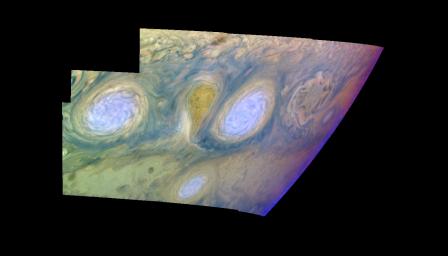
|
Jupiter’s Long-lived White Ovals in False Color (Time Set 4)
- Click the image above for a larger view
- Full-Res JPEG (1400 x 800) (67.9 kB)
- Full-Res TIFF (1400 x 800) (1.5 MB)
Caption:
Oval cloud systems of this type are often associated with chaotic cyclonic systems such as the balloon shaped vortex seen here between the well formed ovals. This system is centered near 30 degrees south planetocentric latitude and 100 degrees west longitude and rotates in a clockwise sense about its center. The oval shaped vortices in the upper half of the mosaic are two of the three long-lived White Ovals that formed to the south of the Red Spot in the 1930's and, like the Red Spot, rotate in a counterclockwise sense. The east to west dimension of the leftmost White Oval is 9000 kilometers (km). (The diameter of the Earth is 12,756 km.) The White Ovals drift in longitude relative to one another, and are presently restricting the cyclonic structure.
To the south, the smaller oval and its accompanying cyclonic system are moving eastward at about 0.4 degrees per day relative to the larger ovals. The interaction between these two cyclonic storm systems is producing high, thick cumulus-like clouds in the southern part of the more northerly trapped system.
This mosaic uses the Galileo imaging camera's three near-infrared wavelengths (756 nanometers, 727 nanometers, and 889 nanometers displayed in red, green, and blue) to show variations in cloud height and thickness. Light blue clouds are high and thin, reddish clouds are deep, and white clouds are high and thick. The clouds and haze over the White Ovals are high, extending into Jupiter's stratosphere. There is a lack of high haze over the cyclonic feature. Dark purple most likely represents a high haze overlying a clear deep atmosphere. Galileo is the first spacecraft to distinguish cloud layers on Jupiter.
North is at the top of this mosaic. The smallest resolved features are tens of kilometers in size. The planetary limb runs along the right edge of the mosaic. Cloud patterns appear foreshortened as they approach the limb. These images were taken on February 19, 1997, at a range of 1.1 million km by the Solid State Imaging (CCD) system aboard NASA's Galileo spacecraft.
Background Info:
The Jet Propulsion Laboratory, Pasadena, CA manages the mission for NASA's Office of Space Science, Washington, DC.
This image and other images and data received from Galileo are posted on the World Wide Web, on the Galileo mission home page at URL http://galileo.jpl.nasa.gov. Background information and educational context for the images can be found at http://www.jpl.nasa.gov/galileo/sepo .
Cataloging Keywords:
| Name | Value | Additional Values |
|---|---|---|
| Target | Jupiter | |
| System | Jupiter | |
| Target Type | Planet | |
| Mission | Galileo | |
| Instrument Host | Galileo Orbiter | |
| Host Type | Orbiter | |
| Instrument | Solid-State Imaging (SSI) | |
| Detector | ||
| Extra Keywords | Atmosphere, Color, Haze, Infrared, Rotation, Storm | |
| Acquisition Date | ||
| Release Date | 1998-03-26 | |
| Date in Caption | 1997-02-19 | |
| Image Credit | NASA/JPL-Caltech | |
| Source | photojournal.jpl.nasa.gov/catalog/PIA00857 | |
| Identifier | PIA00857 | |
